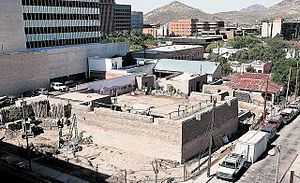Fort Tucson
| Tucson Presidio | |
|---|---|
| Tucson, Arizona | |

The reconstructed northeastern bastion of the Tucson Presidio in 2009.
|
|
| Type | Army fortification |
| Site information | |
| Controlled by |
|
| Condition | tourist attraction |
| Site history | |
| Built | 1775–1783 |
| Built by |
|
| In use | 1776–1886 |
| Materials | adobe, mesquite, earth |
| Battles/wars | |
| Garrison information | |
| Past commanders |
|
| Occupants |
|
Presidio San Agustín del Tucsón was a presidio located within Tucson, Arizona. The original fortress was built by Spanish soldiers during the 18th century and was the founding structure of what became the city of Tucson. After the American arrival in 1856, the original walls were dismantled, with the last section torn down in 1918. A reconstruction of the northeast corner of the fort was completed in 2007 following an archaeological excavation that located the fort's northeast tower.
A company of Spanish Army soldiers, led by Captain Hugh O'Conor, an Irish mercenary working for Spain, selected the location of the Presidio San Agustin del Tucson on August 20, 1775. The site was on the east terrace overlooking the Santa Cruz River floodplain. Nearby was the O'odham village of S-cuk Son (Tucson) at the San Agustin Mission.
The following year, soldiers marched north from the Presidio at Tubac and began construction of the fort. Initially, it consisted of a scattering of buildings, some inside a wooden palisade. Mismanagement of the funds that were to be spent on adobe walls stalled their construction. A near disastrous attack by Apache raiders in June 1782 resulted in renewed efforts to complete the fort, which was accomplished in May 1783. The fort measured about 670 ft (200 m) to a side with square towers at the northeast and southwest corners. The main gate was on the center of the west wall, the presidial chapel was located along the east wall, the commandant's house was in the center, and the interior walls were lined with homes, stables, and warehouses. The massive adobe walls required constant maintenance, especially in times when attacks by Native Americans were anticipated, mostly from Apache. The fortress remained intact until the American arrival in 1856, two years after the Gadsden Treaty transferred southern Arizona to the United States. Afterward, it was rapidly dismantled, with the last standing portion torn down in 1918.
...
Wikipedia
